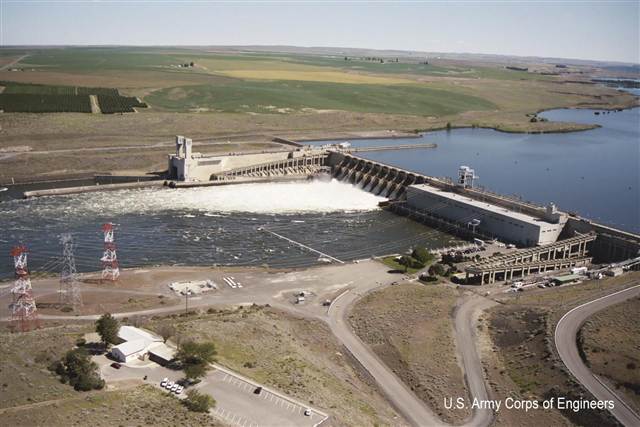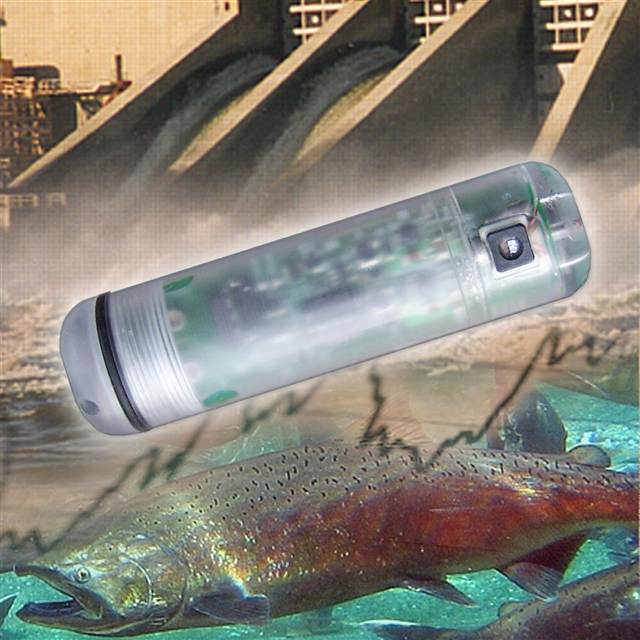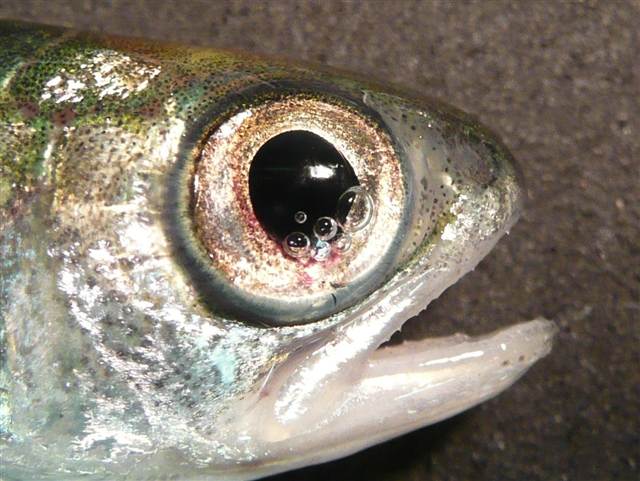forum
library
tutorial
contact

Fish-Friendly Dams? Scientists
Race to Reduce Turbine Trauma
by John Roach
NBC News, April 14, 2014
|
the film forum library tutorial contact |

|
Fish-Friendly Dams? Scientists
by John Roach
|
 A hydroelectric dam building boom in the Pacific Northwest in the past century drove dozens of salmon runs to extinction and has cost taxpayers billions of dollars to try to save the fish that remain. Today, scientists from the region are hard at work to prevent a repeat of history at a time when countries around the world race to wring more energy from rivers to fuel a power hungry and warming planet.
A hydroelectric dam building boom in the Pacific Northwest in the past century drove dozens of salmon runs to extinction and has cost taxpayers billions of dollars to try to save the fish that remain. Today, scientists from the region are hard at work to prevent a repeat of history at a time when countries around the world race to wring more energy from rivers to fuel a power hungry and warming planet.
"We've made some pretty good progress here in the Pacific Northwest on determining criteria that can help keep fish safe," Richard Brown, a senior research scientist at the Department of Energy's Pacific Northwest National Laboratory in Richland, Wash., told NBC News.
Brown and his lab colleagues are collaborating with researchers from Laos, Brazil and Australia to apply what they've learned to reduce injury and death to fish passing through dam turbines on their way to the sea.
The change in pressure that fish experience while passing through turbines causes a rapid expansion of a swim bladder used to maintain buoyancy. In some cases, the organ can rupture. The pressure change can also cause pre-existing gas in the body to expand, eyeballs to bulge and stomachs to pop out of mouths. For some species and life stages, injuries from this so-called barotrauma may cause more deaths than lethal injuries sustained when fish are struck by spinning turbine blades, according to Brown.
Hydropower expansion
Research on reducing barotrauma is urgently needed, he and colleagues noted in a paper published in the March issue of the journal Fisheries. There's a push around the world to expand the use of dams to increase water storage and low-carbon energy generation on rivers in developing nations where people "rely heavily on freshwater fish for their livelihood, both as a source of income and food," the paper reads.
For example, the Lower Mekong River Basin, which includes Cambodia, Laos, Thailand and Vietnam, supports an inland fishery worth between $4.3 billion and $7.8 billion annually and provides as much as 80 percent of the region's total animal protein. There are 11 dams in various stages of development on the main stem of the river, which could "lead to a major decline in fish populations, significantly compromising food security," according to the Fisheries paper.
 And that's just one example, according to Jason Rainey, the executive director of International Rivers, a San Francisco-based advocacy group that opposes dam construction. "We are talking about hundreds and hundreds of large dams being proposed on rivers such as the Mekong, the Congo, the Nile, as well as the Amazon and rivers that drain the Himalaya mountains," he told NBC News.
And that's just one example, according to Jason Rainey, the executive director of International Rivers, a San Francisco-based advocacy group that opposes dam construction. "We are talking about hundreds and hundreds of large dams being proposed on rivers such as the Mekong, the Congo, the Nile, as well as the Amazon and rivers that drain the Himalaya mountains," he told NBC News.
Given the global rush to develop hydropower, "building new technologies -- fish-friendly technologies, so to speak -- into designs can be helpful," Rainey noted. He added that "slapping on some turbines that might reduce mortality and labeling that as fish-friendly is definitely sending the wrong signal to the public as to what these dams are doing."
Providing information
"We are just researchers; we are not in anybody's camp," Daniel Deng, a hydrologist at the Pacific Northwest National Laboratory and a co-author of the Fisheries paper, told NBC News. "Our focus," he added, "is to provide the information and criteria so that decision-makers can make the decision" on whether and how to build a dam.
For example, Deng is developing a sensor-laden capsule that resembles a fish -- a so-called sensor fish -- that is sent through turbines to measure the pressure conditions inside. The data, in turn, help the researchers determine whether those conditions would damage a live, migrating fish. This information is then shared with turbine designers, manufacturers and dam operators.
What's desperately needed, according to the researchers, is data on how pressure changes affect fish with different types of swim bladders, at different life stages, in different rivers around the world. Most information to date is from juvenile salmon impacted by dams in the Pacific Northwest.
One key lesson emerging from the salmon research is that modifications to turbine design to minimize large pressure drops -- that is, trying to maintain a minimum pressure as the fish pass from the intake, through the turbine and back out into the river -- could help more fish pass safely through the dams.
"The way that we elevate those minimum pressures is through blade shape modifications," Martin Ahmann, a senior hydraulic engineer with the Walla Walla District of the U.S. Army Corps of Engineers, explained to NBC News. He has worked with the information from Brown's team on barotrauma in juvenile salmon for a planned replacement of turbines at the Ice Harbor Lock and Dam on the Lower Snake River in Washington.
He and colleagues use computer models of how water flows through dams to calculate the pressure of a given turbine design. They've found, for example, that the addition of an extra blade to the typical type of turbine in Pacific Northwest dams may maintain a higher pressure for the fish, but could also elevate the risk of blade strike. Other approaches include changing the shape of turbines and the location where they are placed in the dam.
Improved turbine designs
 Advances in technology such as computer modeling and analysis have resulted in hydropower turbines that are about 2 percent to 3 percent more efficient today than those designed for dams built in the mid-20th century, according to Ahmann. These efficiency gains drop by about 1 percent when the designs include measures to reduce fish mortality.
Advances in technology such as computer modeling and analysis have resulted in hydropower turbines that are about 2 percent to 3 percent more efficient today than those designed for dams built in the mid-20th century, according to Ahmann. These efficiency gains drop by about 1 percent when the designs include measures to reduce fish mortality.
The team will find out about the effectiveness of the fish-friendlier design when new turbines are tested at the Ice Harbor Lock and Dam, beginning in 2016. "And even then, we will not be able to necessarily break out any increases in survival that we may have gained (as) as result of improved turbine pressures or the result of reduced strike or just general hydraulic flow conditions through the turbine," he said.
What's more, the team's work for the Ice Harbor project is specific to the fish -- salmon and lamprey -- that pass through the dam with a specific type of turbine. The "results are not directly applicable to anything else," Marvin Shutters, a fisheries biologist with the Corps of Engineers, explained to NBC News.
In other words, a turbine design that allows more juvenile fish safe passage on the Lower Snake River may be irrelevant to passage of fish in proposed dams on the Mekong or Nile. The fish, for one, may have different biological characteristics. In addition, the hydraulics of the dams themselves will present unique sets of challenges. Identifying and modeling all these factors will be necessary if hydropower developers are to stand a chance of reducing harm to migrating fish, Brown noted.
"There are a lot of research gaps," he said.
Ultimately, other techniques may afford fish a greater chance of getting through, around or over dams, such as fish ladders, barges and spillways, which are how more than 90 percent of seaward salmon in the Pacific Northwest make the trek. But even those measures, noted Rainey with International Rivers, may be futile for charismatic creatures such as the Mekong giant catfish in Asia. They require access to much of the Mekong throughout various life stages for survival but are unlikely to successfully navigate any fish ladder.
"There might be some technologies that can mitigate or minimize kills," Rainey said, "but the notion that a dam will somehow be fish-friendly or will be supportive of native fish, I don't think that there is much evidence to support that that's the case."
learn more on topics covered in the film
see the video
read the script
learn the songs
discussion forum
